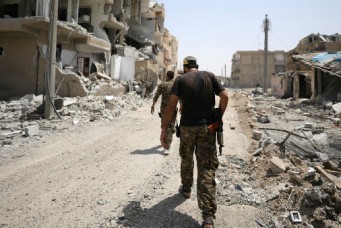Fall 2018
Throughout its history, the Middle East has been an arena for great power politics. Today, massive upheaval and wars in the region have created new realities on the ground, which foreign powers have sought to exploit. The results of such interventions have varied from the downsizing of American engagement with the region to the rise of China’s role and Russia’s renewed diplomatic activism, to name but a few.
Much of these recent external interventions can be traced back to the regional disorder following the 2010–11 Arab uprisings. Driven to contain the fallout of the post-Arab Spring turbulence, the United States stepped in militarily and diplomatically to curb the proliferation of weapons of mass destruction in Syria and Iran and intervened militarily alongside several European allies to defeat the Islamic State in Syria and Iraq; the Russian Federation launched an intensive military campaign to prevent the collapse of the Syrian regime; and member states of the European Union organized a coordinated drive to stem the flow of migrants and refugees fleeing the region’s conflicts. In addition, the rising powers of China and India have gradually been swept into the maelstrom by trying to safeguard their interests in the region.
How have these world powers then attempted to adapt themselves to these realities and shape a new regional order? We asked a select group of authors to offer their reflections from the vantage point of their capitals under the theme of “The Middle East from the Outside in.” Jon B. Alterman and Pierre Vimont provide the perspectives from Washington and Brussels in their respective essays, “The Inflection Point” and “Europe: In Search of a Role.” Both present an assessment of the confusion, conflicting priorities, and general lack of policy coherence, a reality also captured by Daniel Levy in his essay on Western foreign policy toward the region. David Wearing offers the view from London, while Marco Pinfari presents that from Rome, and Frédéric Charillon, Paris. In his essay, “Russia’s Sharp Turns,” Dmitry Shlapentokh analyzes the complex interests driving Russia’s renewed activism in the region. Degang Sun and Kabir Taneja write from the standpoints of Beijing and New Delhi in that order. Finally, through the story of the Red Sea fishing village of Suakin, Nanjala Nyabola’s essay offers a fresh perspective on Africa’s often troubled relationship with the region. Nabil Fahmy’s Nile View column focuses on the challenges facing Arab statesman in countering the misperceptions that often drive Western policy toward the region.
Finally, this fall issue of the Cairo Review features a redesign of the journal produced by a talented Cairo-based team of graphic designers and artists. With a fresher, more innovative look, we hope our readers will find our new design to be in keeping with the core mission of the Cairo Review as high-quality journal of opinion and original commentary covering a diverse set of issues that touch upon the Middle East and the Arab World.




